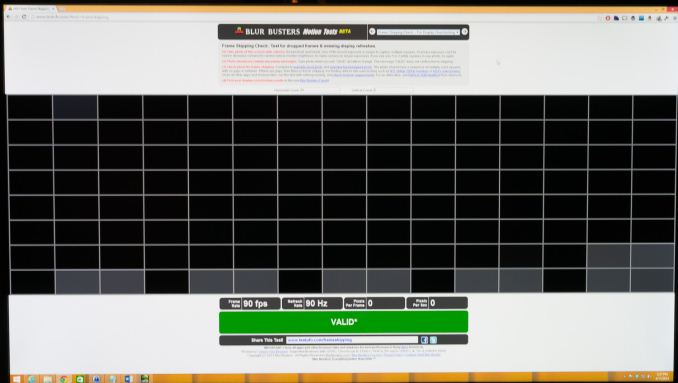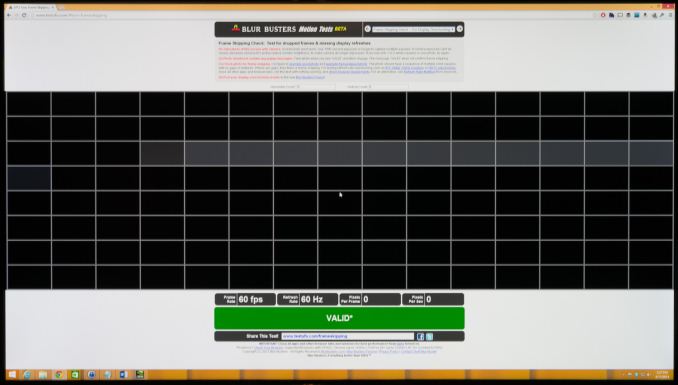QNIX QX2710 LED DPmulti True10 Review
by Chris Heinonen on April 11, 2014 6:00 AM EST_678x452.jpg)
The best thing to happen to the computer monitor marketplace has been the introduction of inexpensive QuadHD displays from South Korea. At a time when a $700 monitor was considered cheap in the United States, these were available on Ebay for around $300 and utilized the same panel as more expensive offerings, though often with a lower grade panel. The introduction of these displays forced mainstream vendors in the USA to introduce more affordable models, and saw other vendors introduce more affordable products as well.
As good as this introduction has been for consumers, I always held back from recommending the displays to most people. One reason is that as an imported product that lacks a US distributor, there was very little warranty associated with them. If you received a model that had issues from a seller on Ebay, the service or replacement options you could expect were really up in the air.
Second, there was no real testing being done on them. A review sample of a foreign, imported product was impossible to get, and just buying them to test isn’t feasible. Now I finally have been offered one of these displays to test, the QNIX QX2710 LED DPmulti True10 (henceforth called the QNIX in this review). With an updated 10-bit panel and a DisplayPort input, it offers more spec-wise than the previous models. Instead of being limited to a DVI input, it also includes DSub, DisplayPort, and HDMI inputs. The panel is a 10-bit model which it accomplishes by being 8-bit with A-FRC to simulate the last two bits. Taking full advantage of a 10-bit panel is hard to do and is usually limited to just a few applications, but being true 8-bit is important.
There is an on-screen menu system that offers adjustments for Brightness and Contrast, color temperature, and a dynamic contrast mode. Enabling the Dynamic Contrast mode disables the Brightness and Contrast controls, while also setting the light output to a retina-searing level. Navigating the menu system is pretty easy overall, though not at the level of the best displays.
There is a pair of 5W speakers built into the rear of the display and they sound like most speakers on the rear of a monitor. Sound is muffled and they’ll work in a pinch, but I wouldn’t want to use them on a daily basis. One semi-interesting feature is that the QNIX can accept a 4K input and then it scales it to 2560x1440. I don’t see a reason to do this with a PC, but with a video device (i.e. a future 4K Blu-ray player, or a video game system) where your output choices are limited to 4K or 1080p, the downscaled 4K image could look better on the QNIX than upscaled 1080p.
The specs suggest that the QNIX can be overclocked to 120Hz by using a custom resolution setting for the video card, but I am unable to make it work in any configurations that I've tried (DisplayPort or DVI, AMD or NVIDIA cards). Going to 110Hz worked fine, but higher settings did not for me. It might be a panel lottery, where some work at 120Hz and some do not, but I wouldn’t assume you will get 120 Hz to work for certain. Still, pushing beyond 60Hz is at least possible.
Update: Commenters pointed out that the QNIX "overclocks" by dropping frames. To test this I used the QNIX on TestUFO.com at both 90Hz and 60Hz and took 1/5 second exposures of the Frame Skipping Check. Below you can see screenshots showing that at 90Hz, the QNIX is simply dropping frames instead of creating extra frames. At 110Hz I began to get sparkles on the screen, obviously pushing the limits of what the panel can do. Because of this, I'd discount any overclocking mentions from the QNIX as it isn't a true higher referesh rate panel.
The monitor stand offers only a tilt adjustment, with no height, pivot or swivel. A nice design cue is the inputs being on the side of the monitor and not on the bottom. Placing them on the bottom makes hooking things up hard and I wish fewer companies would do it, particularly on budget models with no height adjustment.
| QNIX QX2710 LED DPmulti True10 | |
| Video Inputs | HDMI 1.4a, DisplayPort, DVI, Dsub |
| Panel Type | AHVA |
| Pixel Pitch | 0.231mm |
| Colors | 1.07 Billion |
| Brightness | 350 cd/m2 |
| Contrast Ratio | 1000:1 |
| Response Time | 4ms GtG |
| Viewable Size | 27" |
| Resolution | 2560x1440 |
| Viewing Angle (H/V) | 178 / 178 |
| Backlight | LED |
| Power Consumption (operation) | 46 W |
| Power Consumption (standby) | 0.5 W |
| Screen Treatment | Anti-Glare |
| Height-Adjustable | No |
| Tilt | Yes |
| Pivot | No |
| Swivel | No |
| VESA Wall Mounting | Yes, 100mm VESA |
| Dimensions w/ Base (WxHxD) | 25 3/8" x 18 1/2" x 6 3/4" |
| Weight | 10.2 lbs. |
| Additional Features | 3.5mm stereo in, 3.5mm stereo out, 2x5W speakers |
| Limited Warranty | 1 year |
| Accessories | 3.5mm audio cable, DVI cable, power adapter |
| Price | Around $365 via eBay |


_thumb.jpg)
_thumb.jpg)
_thumb.jpg)
_thumb.jpg)
_thumb.jpg)
_thumb.jpg)
_thumb.jpg)
_thumb.jpg)
_thumb.jpg)
_thumb.jpg)
_thumb.jpg)
_thumb.jpg)










85 Comments
View All Comments
kevinsbane - Friday, April 11, 2014 - link
This model of the Qnix doesn't overclock properly. Overclocks of monitors need to be validated to verify that it doesn't skip frames when overclocked.This particular model will not show every frame of an overclock - for example, a 90hz overclock will actually result in the monitor only showing 2 out of every 3 frames. Try using the UFO test: Frame Skipping Checker to ensure that your monitor does properly overclock.
CSMR - Friday, April 11, 2014 - link
These monitors are not "best thing to happen to the computer monitor market".This is a cheap monitor and it shows.
Full of gimmicks too (integrated speakers, downscaling of 4k).
I don't know why it's appearing on Anandtech.
The front page is also unclear and doesn't state the panel type as far as I can see.
DanNeely - Friday, April 11, 2014 - link
It's here because for several years people have been requesting that some of the cheap 27" panels be reviewed for comparison with higher end models.peterfares - Friday, April 11, 2014 - link
Because the resolutions are awesome. We've been stuck at 1920x1080 for YEARS. It's about time we moved up to something better.cheinonen - Friday, April 11, 2014 - link
Because if these displays hadn't come out, we'd probably still be paying $1,000 and up for a quality 27" panel in the US. Now you can get a nice display for $450 and a really nice one for $600-650. Even if the quality of the $300 models isn't great, it has still put pressure on the pricing of the higher-end models and made them more affordable.CSMR - Friday, April 11, 2014 - link
Not sure about that. I think if you produce a high quality 27" display your main competition is other high quality 27" displays, and after than high quality 23 or 24 or 30" displays.If it were a good value cheap product I would understand. But there are much better ways to make a cheap product. Take out the frills, stick with a single displayport, skimp on casing and stand. Putting a lot of cheap parts together and adding some extra cheap parts for the hell of it is not the way to make a good value product.
Hxx - Friday, April 11, 2014 - link
Chris you made my day by reviewing this panel. Thanks for sharing with the world how awful these korean monitors actually are.JoeArchitect - Friday, April 11, 2014 - link
Don't jump to conclusions now.First of all - these aren't the monitors people want from Korea, the ones you buy are the QNix QX2710 and the X-Star DP2710 (or the Catleaps if you want to go back in time to when this started).
Secondly, for $300 you get a fairly good monitor that has a 1440p resolution and is overclockable anywhere from 96 to 120 Hz (and beyond if you're really lucky). I'm not sure if the reviewer was aware, but the monitor he selected probably actually isn't overclocked to 110 FPS. This model simply drops the frames, you have to test for frame skipping, not just what it "says" it's overclocked to. Multi-input models are widely known to do this while the single-input models actually do overclock.
The input lag the reviewer reported is also due to the multiple inputs. The single input version actually has a 2-3ms input lag, which is very good. So that downside wasn't a big surprise to many readers who have researched these panels in the past.
Now I won't deny that these (I'm referring to the desired models, not the reviewed model) monitors do have a "luck of the draw" kind of statistic to them, but even in the worst of cases purchasing a QNix or X-Star monitor gives you access to a quality panel (Samsung PLS - the one the reviewed is AHVA) that isn't available until you start spending hundres more - and those stay at 60 Hz.
For the money you spend you're getting great value, do you know of a comparable monitor that can produce >=96 Hz at 1440p on a Samsung PLS panel for ~$300? I'd love to know if you do, because I'm in the market for a new one and was going to purchase a second X-Star DP2710 because I love the one I have.
I'm disappointed in Anandtech for publishing this, they really dropped the ball and obviously didn't research much into what they were reviewing before posting this. I've been dying to see a review of the Samsung PLS model QNix and X-Stars against more expensive models, but what we got ignored a lot of community research that has been happening over the many years these inexpensive monitors have been available.
JoeArchitect - Friday, April 11, 2014 - link
As an addendum, the fact the "wrong" model was reviewed isn't bad in and of itself. The fact the misconception of the negative aspects of this multi-input model is spreading to "all Korean models" because of an utter lack of mentioning the other variants is unacceptable.I do applaud the reviewer for at least killing the misconception of this model being actually overclockable through his edit he just posted; that said, the fact the review mentions the "QNix" as not overclockable without mentioning the single-input variants which ARE is quite disheartening.
I wonder if the other reviewers on this site have an equal lack of understanding for the products they're reviewing as Chris does for monitors.
vgu - Tuesday, April 15, 2014 - link
I totally agree on all points. This seemed thoughtlessly put together and was way below the level of thoroughness I've become accustomed to on Anandtech.